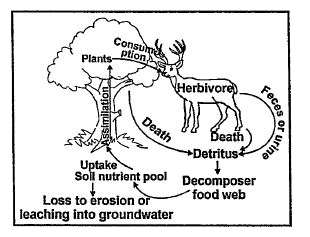Which of the following pair is a sedimentary type of biogeochemical cycle?
A
nitrogen and carbon cycle
B
phosphorus and carbon cycle
C
nitrogen and sulphur cycle
D
sulphur and carbon cycle
Video Solution
Text Solution
The correct Answer is:A
|
Answer
Step by step video, text & image solution for Which of the following pair is a sedimentary type of biogeochemical cycle? by Biology experts to help you in doubts & scoring excellent marks in Class 12 exams.
Updated on:21/07/2023
Topper's Solved these Questions
Similar Questions
Knowledge Check
- Question 1 - Select One
Which of the following pair is a sedimentary type of biogeochemical cycle?
Aphosphorus and nitrogenBphosphorus and sulphurCoxygen and nitrogenDphosphorous and carbon - Question 2 - Select One
Which of the following paris is a sedimentary type of biogeochemical cycle ?
APhosphorus and nitrogenBPhosphorus and sulphurCOxygen and nitrogenDPhosphorus and carbon - Question 3 - Select One
A sedimentary type of biogeochemical cycle is:
ACarbon cycleBSulphur cycleCNitrogen cycleDHydrologic cycle
What are biogeochemical cycles?
View SolutionWhich among the following has a sedimentary cycle?
View SolutionWhich of the following is not a sedimentary rock?
View SolutionWhich one of the following is the sedimentary cycle?
View SolutionUsing the figure, which o f the follow ing is NOT true o f the biogeochemical cycle?
 View Solution
View Solution

